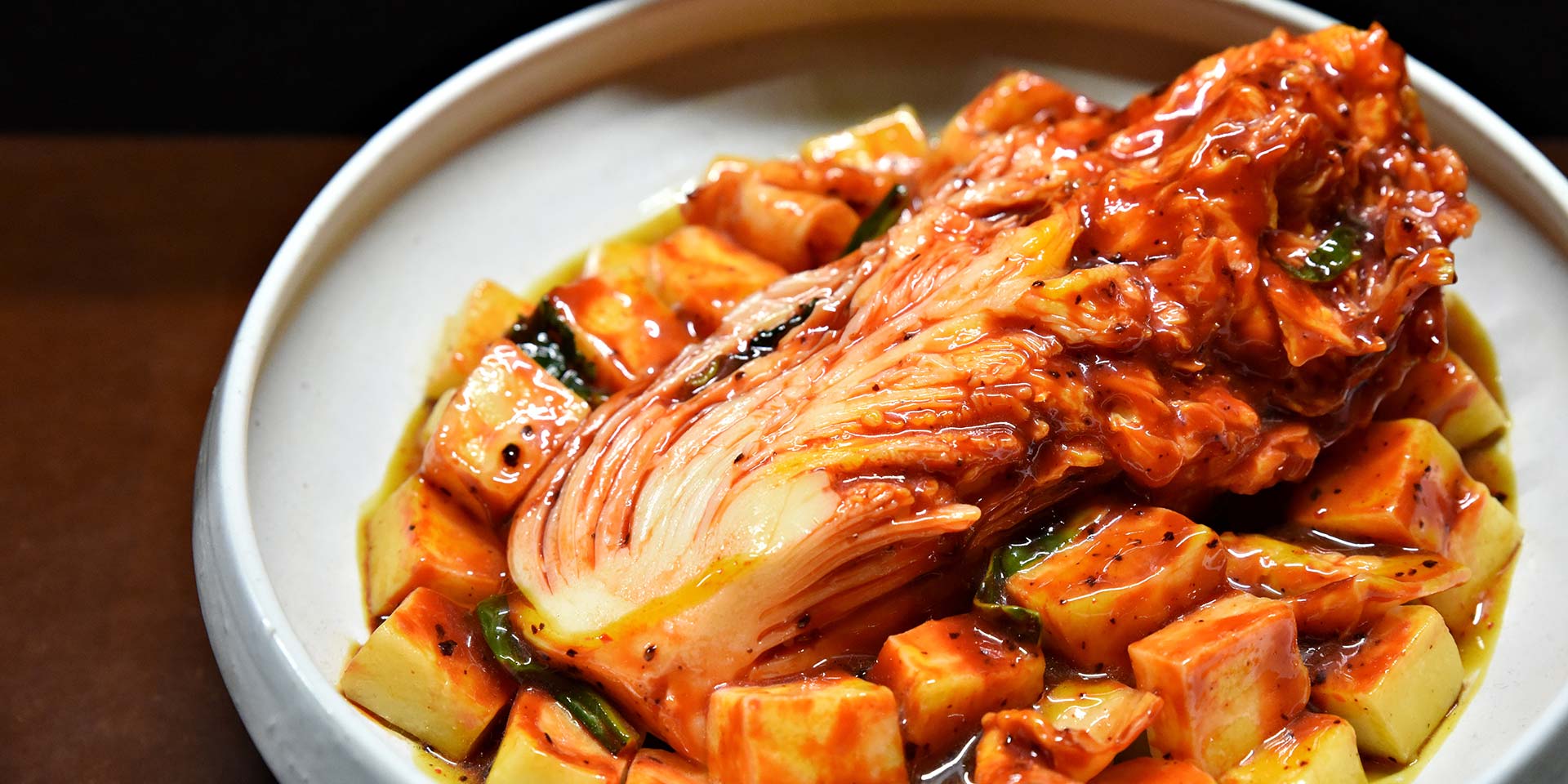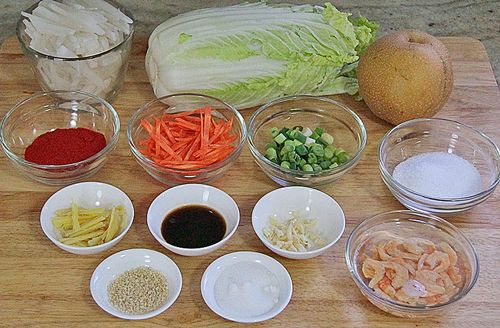September 27, 2022—Food System
Get to Know the Kimchi
I know it looks weird, but that’s what makes it unique. Kimchi originates from Korea in the region of Asia. Its everyone’s go to favorite side dish. Kimchi is delicious and spicy. Those that enjoy this combination of flavor will surely enjoy this dish.

credits to remoteland.com
What is Kimchi?
First of all, Kimchi is a side dish that add a little spice/bitter taste to your food. The dish is nutritious and delicious. Kimchi is mainly made out of Chinese cabbage and radish; you can produce kimchi anywhere with a few ingredients. What makes Kimchi different? According to an article by Korean Society of Food and Culture, Journal of The Korean Society of Food Culture: , indicates that it is different kind of pickled vegetable than Chinese paochai (appetizer of pickles with various veggies), Japanese tsukemono (Japanese style pickles), and western pickles, it is the only dish that is a pickle vegetable fermented and ripped animal seasoning called jeotgal (type of marine life) for taste. Kimchi contains valuable nutrients and a special flavor called umami that makes the dish unique. Other than being on the side, kimchi can even be made into a full meal. Those meals can be Kimchi Pancakes, Kimchi Jjigae, kimchi fried rice, kimchi Hot pot, Kimchi Udon noodle stir fried, Baechu kimchi, Napa Cabbage, and much more. Kimchi is made by hand.

kimchi noodles credits-www.cookerru.com
Kimchi origin and production comes mostly from Korea. Kimchi is popular in Korea but is also growing rapidly economically especially in America. Where in the United Sates you can probably find it in your typical grocery store hand made. An article by Kang. H and Lee. B. H of the
Sovereignty over Kimchi, stated data that shows how much kimchi can economically grow, “imported kimchi sales are estimated to rise
4.5% year-on-year to US$256.5 million.” In addition to that, the author also mentions, “kimchi manufacturing companies has increased from 249 in 2015 to 264 in 2017, with an increase in the total production output from US$888.88 million to US$1,040.28 million in the same period.”
KIMCHI’S HISTORY
Kimchi is a traditional and typical side dish in Korea. Kimchi’s history is part of Korean history. Kimchi originates from Korea and was invented in the Goryeo Period (918-1392). And during this time winters were harsh, and Koreans learned to adapt, store their foods (this process was called fermentation-preserving and encouraging the growth of natural beneficial bacteria), and in the process created kimchi. The dish exploded with trading with other kingdoms and countries
new vegetables found their way to Korea, including napa or Chinese cabbage. Indeed, kimchi has come a long way. Over time, kimchi evolved into the dish we know today.
Not only is it delicious, but is for sustainability (its benefits)
Did you know that kimchi is one of the healthiest foods in the world. Kimchi is basically made out of vegetable (cabbage) and healthy seasoning. Based on the article of kimchi by authors Daniel Park, Bobby Sidhu, and Fred Shaw, states that kimchi carries vitamins and natural vitamins, and bacteria that are all beneficial to the human body. First of all, kimchi is low in calorie, contains no cholesterol, and has rich sources of vitamins. Those vitamins are vitamin A, B, C, and K. Kimchi also carries iron, calcium, phosphorus, and selenium. kimchi helps prevent ageing, cancer, and contains Spor biotics lactic acids, which could be an advantage to the immune system. Which is why this dish is popular in Koreans diets as its healthy, complements their dishes, and affordable. However, there are some things you need to take in consideration. Kimchi needs to be taken in thorough moderation due to high in sodium and added sugars that can be triggering to our body system. More importantly, Kimchi is easy to make, so easy where anyone came make it at the comfort of their home. Kimchi is known for being hand made in which benefits circular economy. Kimchi minimizes waste, and disposal as it can be stored for a great amount of time. In result of lessening the need to buy more. Which it can help regulate energy production and issues of storability. Which makes kimchi for sustainability.
Are you interested in making some kimchi? Well, you’re in luck. Kimchi has a pretty basic recipe that anyone can follow in the comfort of your home. Recipe from the author Nobuko Hongu and Sunmin Park: The Journal of Ethnic Foods, provides a well written recipe.

ingredients-credits- coolnooby.Blogspot.com
- First, you will need a large bowl (depending on your desired amount), and primary the Savory cabbage (best option)
- About sixteen cups of water, and 1 cups of sea salt. Salt water.
- Half a cup of cooking salt (size of crystals).
- About two teaspoons of sweet rice flour
- One and a half cups of water, include a cup and a half of gochutgaru Korean red chili flakes (important ingredient)
- Add about nineteen ounces of Korean radish.
- One tablespoon of fine sea salt
- Add three and a half teaspoons of Korean fish sauce
- 3.2 Onces of Korean chives (cut to the size of 2 inches of length)
- Half a tablespoon of ginger and two tablespoons of raw sugar.
- Next, add one hundred and forty grams of carrots, julienned
- One-fourth cup of minced garlic, and seventy grams of blended garlic, Korean radish
- One tablespoon of fine sea salt
- Add two tablespoons of fermented shrimp minced.
- Lastly, add one hundred and forty grams of carrots, julienned
- One-fourth cup of minced garlic, and seventy grams of blended garlic.
Recipe’s main ingredients details
- Kimchi’s cabbage usage (Napa cabbage) comes from China. It provides nutrients, vitamin C, helps with digestion and cholesterol. It is produced in farms, takes up to 50-80 days to grow with sunlight and good soil conditions.
- chives (green onions) originate from native Asia. Its strengths bones, heart, and keeps low blood pressure. It is produced in sunny temperatures, harvest when matured up to 6-8 inches
- red flakes are originally from China made from cayenne peppers for spice and from dried and crushed red chili peppers. They help fight stress, reduce digestion problems, and inflammation.
My Reflection
Overall, I was able to have a deeper understanding of why kimchi is growing in popularity, its benefits to us, and for the environment (sustainability). Based off of my research, the data of the journals, the research, and the healthy ingredients should be acknowledged more in order influence people about this delicious, spicy, unique dish.
References
Hongu, N., Angela. S, Suzuki. A, Wilson. H, & Karen. C (2017) Korean kimchi: promoting healthy meals through cultural tradition. Journal of Ethnic Foods, 4(3). doi: https://www.sciencedirect.com/science/article/pii/S2352618117301373Korean kimchi: promoting healthy meals through cultural tradition – ScienceDirect
Park. D. (2015) Kimchi: Determining the rapidity of acidification depending on temperature. 3-4, doi: https://journals.bcit.ca/index.php/ehj/article/view/127/112,
Kwon. D, Jang. D, Yang. H, & Chung. K (2014) History of Korean gochu, gochujang, and kimchi. Journal of Ethics Food, 1(1), 3-7. doi: https://www.sciencedirect.com/science/article/pii/S2352618114000043
Kim. H.R (2021) The Background and Truth of the Controversy over kimchi Suzerainty, And Countermeasures – Focusing on the Birth, Process, and Uniqueness of kimchi. Journal of the Korean Society Food Culture. 36(3)1. doi: https://koreascience.kr/article/JAKO202120763300175.page
Kang. H. J, Lee. B. H (2020) The FFTC Journal of Agricultural Policy. Fosterage of Kimchi Industry in Korea to Reaffirm its Sovereignty over Kimchi. (1)9, 1-2. doi: https://ap.fftc.org.tw/system/files/journal_article/Fosterage%20of%20Kimchi%20Industry%20in%20Korea%20to%20Reaffirm%20its%20Sovereignty%20over%20Kimchi.pdf
Blog post- by Lesly Amador